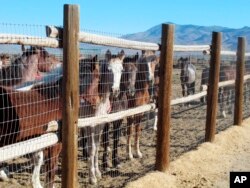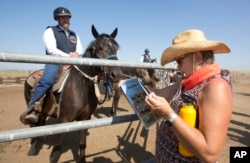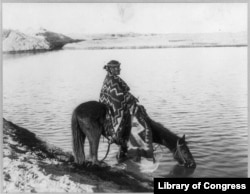Lawmakers in the U.S. House of Representatives and Senate are locked in debate over what to do about wild horses which roam across Western range lands and reservations, competing with domestic livestock for food and water and scarring the environment. Native American tribes and nations are also grappling with the problem. Everyone agrees something needs to be done to reduce the wild horse population, but what?
Today's herds descend from runaway or stray horses brought to America by 16th-century Spanish conquistadors. In 1971, with concerns that the numbers were dwindling, Congress passed the Wild Free-Roaming Horse and Burro Act, which directed the Bureau of Land Management (BLM) to manage herds to "maintain a thriving natural ecological balance." Since then, the wild horse population has tripled and is projected to reach 115,000 by 2020.
Their impact on the environment can be devastating: The average adult horse consumes more than two-and-a-half kilos of grass and 75 liters of water a day, leaving less for domestic livestock. Overgrazing leads to the invasion of non-native vegetation — less nutritional than grass. It also causes soil erosion around water sources, threatening water quality.
"Originally, when the 1971 act passed, it allowed the BLM to destroy healthy horses and burros if populations grew too large," said Gillian Lyons, a wildlife fertility control policy manager at The Humane Society of the United States. "Since 1994, save one year, appropriation language has prevented the agency from being able to do that."
Doing more with less
The BLM today conducts periodic round-ups of wild horses and places them into holding facilities. Some horses are adopted out, but placements are relatively few, and it costs the taxpayer about $50 million a year to feed and house the remaining animals. If President Donald Trump's 2018 budget is approved, it would cut BLM's budget by $10 million, and the BLM would have to seek out other ways to manage horse populations.
"They're going to do that in a couple of ways," said Lyons. "One is by reducing any use of fertility control, which they use barely any of now. And the other way is by getting rid of horses in holding facilities. They've been really good thus far by not saying exactly what they are going to do with them."
Earlier this month, a congressional committee voted for changes in the language of an appropriations bill that would allow the BLM to euthanize horses; the Senate Appropriations Committee voted against a bill that would lift prohibitions on horse slaughter, an industry Congress put out of business in 2007.
'Run to death'
It's an emotional issue which Native American tribes have struggled with for years. Some support roundups, but others, including elders and spiritual leaders, say the animals should be treated humanely and not sent to slaughter. The Northwest Tribal Horse Coalition, comprising five tribes and bands in Idaho, Oregon and Washington, says birth control won't curb overgrazing, at least in the short term, and advocates for the slaughter of horses at "humane facilities."
An estimated 48,000 wild horses have the run of the Navajo Nation's 7,000 square kilometers in Arizona, Utah and New Mexico.
"Because we are in a high desert area and with the drought situation, forage has become scarce, and the horses roam around and consume all the grass they can get at," said Duane "Chili" Yazzie, president of the Nation's Shiprock Chapter. "And the problem it's creating for our ranchers, our livestock owners of domesticated cows and sheep, their animals don't get an opportunity to get the grasses that the horses have already cleared."
The Navajo Nation conducts roundups using cowboys on horseback and all-terrain vehicles to chase the horses into entrapments.
"And that process we're very concerned about, particularly with the use of mechanized vehicles. We know of situations where ponies, young horses, have been run to death."
Yazzie has initiated a horse capture program he considers more humane — luring the animals into a corral with bales of hay and feed, returning branded horses to their owners, euthanizing sick and old animals, and sterilizing others that can be returned to the wild. He is also looking to work with agricultural groups to domesticate the horses, and even revive the tradition of horse transport.
"The affinity that indigenous peoples have with horses is very deep, and the traditional-minded folks, the elders, are the first to demand that the horses receive respectful treatment."










